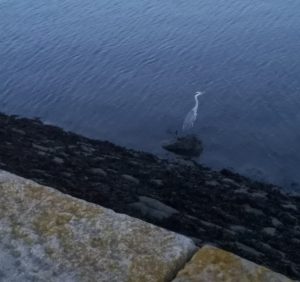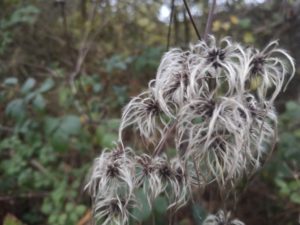Every year, we give over all of December (and usually most of January) to a series called ‘Shadows and Reflections’, in which our contributors share highs, lows and oddments from the past 12 months. Today it’s the turn of Tamsin Grainger.

We’re heading towards the end of the Gregorian calendar year. Again. Once more death rears its head, for it is so closely associated with this late Autumn time in the global North. The high winds have almost stripped the trees bare, the big rains have flooded the drains, swamped the fields and flushed the rivers from their channels.
I am not surprised to be attending another funeral, standing by the graveside and hearing the geese yonking overhead, seeing only the midrib and veins lying there at my feet because the colourful leaf-blade has composted. As my vision blurs, I feel blank, empty in my middle. The mercury in my bones has dropped and my sinews are chilling. Afterwards, walking between twisted shins of yew, its blood dripping, my thoughts inevitably turn to the long dark, and by the time the courtege is slowing to the wake, not even the coming fires of Xmas mask the anticipation of the approaching frosts that the first three months of the new year will inevitably bring.
What am I to do? When the sadness comes over me like this, where can I go? Where can I go when the reminders of mortality are all around?
For a walk.
On the plan, the first tower blocks that the developers built on the reclaimed harbour are tucked under the table of an incongruous Pi π shape of water. This table has a rectangular top and two stiff legs such as my youngest child, who has now grown up and left home, used to draw. From the Western wall, today’s vantage point, the water is the turquoise of a municipal swimming pool, result of one of those clear, autumnal skies that Scotland does so well. It is the last quarter; season, yes, of mist, and of endings.
Turning inland, I note the arboreal skeletons once more gracing the horizon; on the wasteland, the hair of the hedgerow clematis has turned white, beautifully coiffed, and on the ground the chamomile has been frosted, once proud heads now drooping.

In the dip between me and the Pi π, is an irregularly-shaped, but ambitious puddle, and the roofs of the housing stacks and the screeching-silent gulls flying above them are deeply drowned in it. I am reminded of the bottomless lochs of the Scottish Highlands I have been studying on the Bathymetric Maps in the National Library of Scotland. I imagine plotting this puddle’s soundings on cloth like Bartholomew used to, shading it in increasingly intense variations of baby-blue, cerulean-blue, and lapis lazuli. My own mini-loch has a little island with a mirror image beneath it, a random rock with a crow who rents the air.
One upside-down Easyjet aeroplane slides across the pit of the puddle. An orange smear, it hovers, revving, waiting for the go-ahead to complete its journey into Edinburgh Airport. The roar reverberates against the blank eyes and protruding lower lids of the upright flats, and the noise hits me so I fear I’ll topple backwards into the ocean. I have a heavy heart — it’s been bothering me for a while now — so I clamber down.
The Wall walk takes me past where the railway station used to be, along to the point. This is the site of the Breakwater Lighthouse, and the wind is wilder here, forcing its way up the Firth of Forth to Grangemouth with its putrid smell and spewing chimneys.
I stand. Very still. I watch the single, peering heron where it balances below me, at the sea’s edge. Occasionally, languorously, it blinks. This was the year that climate loss hit me full in the chest. There used to be so many curlew feeding on the playing fields at Ferry Road that I was unable to count them, but this November there were only four. Numbers of my favourite black and white waders — the eider ducks and oystercatchers — have been almost halved. I used to trek abroad a lot, long-distances from village to town to city, but since the pandemic I have been walking in the same places year-round and it’s brought the truth home to me.
When the world slowed because of it, some of us momentarily managed without flying abroad all the time, and we appreciated listening to the birds, concentrated more on what is happening. But now? Can this terrible rush to destruction ever slow down again so that we have time to think of creative alternatives? And how important is it for me to do that myself, to set an example? Influenced by the urgency of the lives around me, I can’t always find the quiet I need to try and make sense, to integrate the changes. I’m taken up with my sorrow, well, not just with sadness, with anger as well; it’s exhausting. I need a break from the vigil, but the autumn leaves fall and they fall, they pile up at the sides of the roads. They are rotting.
Incredibly, I doze then (maybe my system needs a rest). I travel somewhere and nowhere for a moment. Swaying dangerously on the spot, I lift open my eye hoods and as if the heron was disturbed by that small gesture, she is slow-motion flapping, dragging her feet behind her so they part the waters, flying into the mirage of Inchkeith Island. ‘Oh’, my words follow her out there, ‘it is dusk’.
As I walk back in the gloom, up Waterfront Avenue and the evenly spaced, newly-placed lime trees, I turn the corner and my gaze is drawn to tyre-imprinted earth, not trunks, to a dog’s nose sniffling around in doodles as if he is looking for what used to be. I am disbelieving. Tens of years of patient growth has been bulldozed since I was last here. I was warned it would happen, but it is no less devastating.
Felled in the face of development, some were willow and silver birch saplings, and others were well-established alder, all residents of our neighbourhood. Cover for foxes, home for sparrows, bio-diverse and fruitful, perhaps they were not out of the ordinary, but they collected carbon for the perpetuation of the planet amongst other things. Later, I spoke to a young woman who said she lived nearby. She told me that she and other local people had clung to the fences, but that the next day the ground was empty and the trees in straggly piles, the earth desolate. She wept.
It is getting dark as I cross the overgrown carpark, smell the joints whose ends glow outside the caravans, hear the murmurs.
I have my answer: I must see clearly, improve my night vision any way I can.
I trudge home.
Back in my room, I hear a plaintive, irregular pleep pleep. Teetering with one foot on the rim of my bed and cranking the dormer window open with the hand I’m not using to steady myself, cold air cuts into my scalp. I hang out across the slate roof with its neon-mossy cushions. There are five oystercatchers wheeling across the bay and it was they who were calling. Am I just imagining the smudge of pink legs on indigo sky as they disappear?
*
Tamsin Grainger is author of ‘The Wall‘, a Sound Walk situated on the Western harbour wall of Granton Harbour, and has been shortlisted for a Sound Walk September Award.